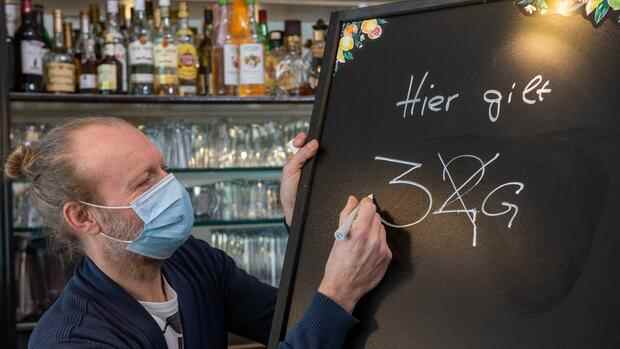As of today, unvaccinated people have access to restaurants and bars again – but only with a negative rapid test.
(Photo: dpa)
Berlin It is another step towards Freedom Day: On Friday, after months of restrictions, further corona measures were lifted.
The 3G rule now applies in the catering and hotel industry, according to which unvaccinated people with a negative test also have access. Clubs and discotheques that have been closed for a long time are also allowed to open again, and the 2G Plus rule now applies there. So only those who have recovered and those who have been vaccinated with a test or with a third vaccination are admitted. In federal states such as Berlin and North Rhine-Westphalia, however, the test is mandatory for all club visitors. The new rules are the second step in the nationwide easing plan that the federal and state governments decided in mid-February.
More guests are now allowed at events. The federal and state governments had stipulated that more vaccinated or recovered spectators (2G) could be admitted to major events than before. Indoors, the maximum number is 6000 people with a maximum occupancy of 60 percent. Outdoors, 75 percent of the maximum capacity can be used, a maximum of 25,000 people are allowed.
Advice on basic protection measures
From March 20th, “all more profound” measures should be dropped if the situation in the clinics allows it. The nationwide legal basis for such measures expires on March 19. Basic protective measures, such as the obligation to wear masks indoors, should remain in place. The traffic light groups want to discuss which rules belong to these basic protection measures in the coming week – and also which measures should remain possible.
Top jobs of the day
Find the best jobs now and
be notified by email.
Federal Health Minister Karl Lauterbach (SPD) recently expressly opposed the expectation of a Freedom Day with the omission of all measures.
According to a survey of 820 retail companies by the retail association HDE, many people will avoid the shopping streets even after the 2G and 3G restrictions have expired. “Many retailers in the inner cities are still registering a significant drop in sales, people are not yet coming back in sufficient numbers,” said HDE General Manager Stefan Genth on Friday.
According to the survey, sales in the non-food trade last week were on average a fifth below the pre-crisis values of 2019. The reluctance to buy hit inner-city retailers particularly hard. On average, customer frequencies in the city centers were only 70 percent of the pre-crisis level.
The clothing and shoe trade as well as medium-sized companies are still doing particularly badly, Genth reported. Things are going much better in sectors other than clothing and shoes. Here the drop in sales compared to 2019 is ten percent.
“The corona crisis and its effects continue to leave a deep dragging mark through inner cities across the country,” said Genth. Ultimately, this threatens entire city centers, because there are no attractive inner cities without lively retail trade. He reiterated the demand for a special program for inner city development with at least 500 million euros annually for a period of five years.
Meanwhile, the number of corona infections rose slightly on Friday for the second day in a row. The Robert Koch Institute (RKI) gave the value of new infections per 100,000 inhabitants per week on Friday morning as 1196.4. The previous day had the seven-day incidence at 1174.1.
The health authorities in Germany reported 217,593 new corona infections to the RKI within one day on Friday, around 7,000 more than a week ago.
Experts assume a high number of cases that are not recorded in the RKI data. One reason is the limited capacity of health authorities, for example, and contacts are often only tracked to a limited extent.
In addition, according to the ALM laboratory association, there are now a larger number of people whose infection is no longer confirmed by a PCR test. These infections are therefore not included in the official statistics.
More: 38 percent: Omicron subvariant BA.2 will probably soon dominate
